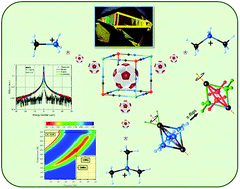Reorientational dynamics of organic cations in perovskite-like coordination polymers†
Abstract
Here we report the dynamics of organic cations as guest molecules in a perovskite host-framework. The molecular motion of CH3NH3+ (MAFe), (CH3)2NH2+ (DMAFe) and (CH3)3NH+ (TrMAFe) in the cage formed by KFe(CN)63− units was studied using a combination of experimental methods: (i) thermal analysis, (ii) dielectric and electric studies, (iii) optical observations, (iv) EPR and 1H NMR spectroscopy and (v) quasielastic neutron scattering (QENS). In the case of MAFe and TrMAFe, the thermal analysis reveals one solid-to-solid phase transition (PT) and two PTs for the DMAFe crystal. A markedly temperature-dependent dielectric constant indicates the tunable and switchable properties of the complexes. Also, their semiconducting properties are confirmed by a dc conductivity measurement. The broadband dielectric relaxation is analyzed for the TrMAFe sample in the frequency range of 100 Hz–1 GHz. QENS shows that we deal rather with the localized motion of the cation than a diffusive one. Three models, which concern the simultaneous rotation of the CH3 and/or NH3 group, π-flips and free rotations of the organic cation, are used to fit the elastic incoherent structure factor. The 1H NMR spin–lattice relaxation time for all compounds under study, as well as the second moments, has been measured in a wide temperature range. In all studied samples, the temperature dependence of the second moment of the proton NMR line indicated the gradual evolution of the molecular movements from the rigid state up to a highly disordered one.



 Please wait while we load your content...
Please wait while we load your content...